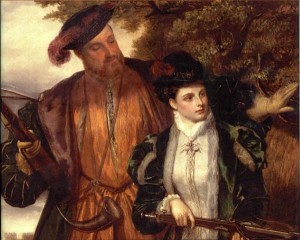 At just before dawn1 on 11th October 1532, Henry VIII and Anne Boleyn, Marquis of Pembroke, set sail on the King’s ship, the Swallow, from Dover. They arrived at their destination, Calais, at 10 o’clock in the morning and were greeted by a “greate peale of gonnes” and procession which included the Mayor of Calais, the Lord Deputy and various knights.2 They were then taken to the Church of St Nicholas where they heard mass before retiring to their lodgings at The Exchequer. The couple stayed together there until 21st October when Henry left Anne to meet Francis I and travel on to Boulogne.
At just before dawn1 on 11th October 1532, Henry VIII and Anne Boleyn, Marquis of Pembroke, set sail on the King’s ship, the Swallow, from Dover. They arrived at their destination, Calais, at 10 o’clock in the morning and were greeted by a “greate peale of gonnes” and procession which included the Mayor of Calais, the Lord Deputy and various knights.2 They were then taken to the Church of St Nicholas where they heard mass before retiring to their lodgings at The Exchequer. The couple stayed together there until 21st October when Henry left Anne to meet Francis I and travel on to Boulogne.
Henry VIII was still married to Catherine of Aragon at this point, but Anne acted as his consort on this trip. He had raised her to the title of Marquis of Pembroke in preparation for this trip and had also presented her with a collection of jewels.3 According to Eustace Chapuys, the imperial ambassador, the King had also demanded that Catherine of Aragon hand back her royal jewels so that they could be given to Anne. Catherine said that “it was against her conscience to give her jewels to adorn a person who is the scandal of Christendom, and a disgrace to the King”, but “if the King sent expressly to ask for them, she would obey him in this as in other things.”4 The King sent for them so Catherine gave them up.
The main purpose of this trip was for Henry and Anne to gain Francis I’s public recognition and approval of their relationship. Henry wanted Francis to then meet with the Pope and push the case for the annulment of Henry’s marriage to Catherine of Aragon. Francis was able to assure Henry of his support and so confident was Henry that the annulment would be granted that he started co-habiting with Anne on their return to England. In the end, Anne actually became pregnant before Francis I had had chance to meet with the Pope, so Henry VIII had to take things into his own hands. He had married Anne in secret in January 1533 so in May 1533 Archbishop Cranmer pronounced the validity of that union and the annulment of Henry’s marriage to Catherine. Anne Boleyn was crowned Queen at Westminster Abbey in 1st June 1533.
Also on this day in history…
- 1521 – The title of Fidei Defensor, “Defender of the Faith”, was conferred by Pope Leo X on Henry VIII. This was a reward for Henry VIII writing his pamphlet Assertio septem sacramentorum adversus Martinum Lutherum (“Declaration of the Seven Sacraments Against Martin Luther”), defending the Catholic Church against the works of Martin Luther. You can read Henry VIII’s Assertio Septem at http://archive.org/details/assertioseptem00henruoft
- 1537 – Solemn procession at St Paul’s to pray for the Queen, Jane Seymour, who was in labour, a labour which lasted over 30 hours. Charles Wriothesley wrote of how the procession was made up of “all the orders of friars, preistes, and clarkes… the major and aldermen, with all the craftes of the citie” and that it was “donne to pray for the Queene that was then in laboure of chielde.”
- 1542 – Death of Sir Thomas Wyatt the Elder, poet and diplomat, at Sherborne in Dorset. He was laid to rest at Sherborne Abbey. His plain tomb can be found in the Wykenham Chapel of the Abbey. See Sir Thomas Wyatt the Elder for more information on Wyatt.
- 1549 – Arrest of Edward Seymour, the Duke of Somerset, Lord Protector of the Realm and Governor of the King’s Person. He was brought in front of Edward VI, who summarised his charges as “ambition, vainglory, entering into rash wars in mine youth, negligent looking on Newhaven, enriching himself of my treasure, following his own opinion, and doing all by his own authority, etc.”
Notes and Sources
- The Maner of the tryumphe of Caleys and Bulleyn states 5 o’clock in the morning whereas chronicler Edward Hall says 3 o’clock.
- The Maner of the tryumphe of Caleys and Bulleyn and The noble tryumphaunt coronacyon of Quene Anne, wyfe unto the most noble kynge Henry VIII, Wynkyn de Worde, p6-7. This can be read at archive.org
- The list of jewels delivered to Cornelius Hayes, the King’s goldsmith, for alteration in September 1532 included “20 rubies and 2 diamonds reserved for my lady Marques”. See LP v. 1376 for the full list.
- LP v. 1377